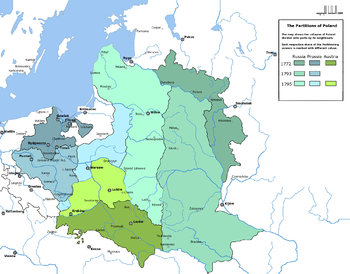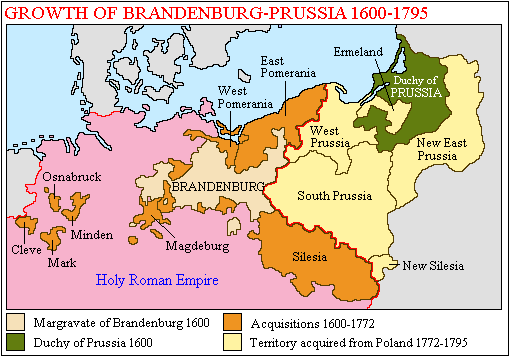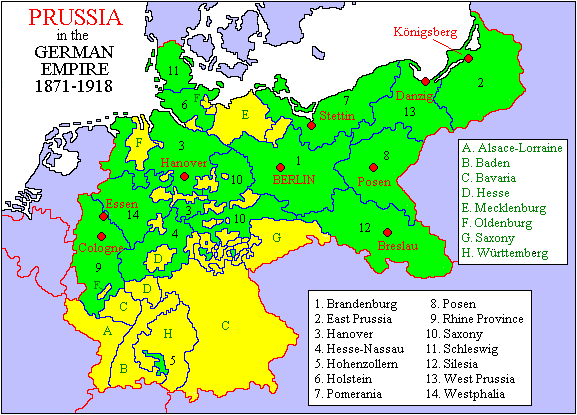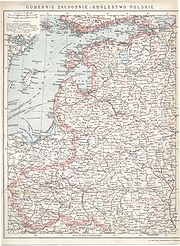
Administrative division of Polish territories after partitions
Encyclopedia

Polish-Lithuanian Commonwealth
The Polish–Lithuanian Commonwealth was a dualistic state of Poland and Lithuania ruled by a common monarch. It was the largest and one of the most populous countries of 16th- and 17th‑century Europe with some and a multi-ethnic population of 11 million at its peak in the early 17th century...
acquired after three partitions of Poland
Partitions of Poland
The Partitions of Poland or Partitions of the Polish–Lithuanian Commonwealth took place in the second half of the 18th century and ended the existence of the Polish–Lithuanian Commonwealth, resulting in the elimination of sovereign Poland for 123 years...
in the late 18th century by the Austrian Empire
Austrian Empire
The Austrian Empire was a modern era successor empire, which was centered on what is today's Austria and which officially lasted from 1804 to 1867. It was followed by the Empire of Austria-Hungary, whose proclamation was a diplomatic move that elevated Hungary's status within the Austrian Empire...
, the Kingdom of Prussia
Kingdom of Prussia
The Kingdom of Prussia was a German kingdom from 1701 to 1918. Until the defeat of Germany in World War I, it comprised almost two-thirds of the area of the German Empire...
and the Russian Empire
Russian Empire
The Russian Empire was a state that existed from 1721 until the Russian Revolution of 1917. It was the successor to the Tsardom of Russia and the predecessor of the Soviet Union...
in the period 1772-1918. These changes were further complicated by the changes within those states and periodic recreations of some form of Polish state itself.
It does not cover the administrative divisions of two main Polish states of the 19th century - administrative division of Duchy of Warsaw
Administrative division of Duchy of Warsaw
Administrative division of Duchy of Warsaw was based on departments. Headed by a prefect, it was a solution adopted based on the French model, as entire Duchy was in fact created by Napoleon and based on French ideas, although departaments were divided into Polish powiats .There were 6 initial...
(1807–1815) and administrative division of Congress Poland
Administrative division of Congress Poland
The administrative division of Congress Poland changed several times. Immediately after its creation, 1815-1816, the Congress Kingdom of Poland was divided into departments, a relic from the times of the French-dominated Duchy of Warsaw. In 1816 the administrative divisions were reformed into the...
(1815–1918). For the administrative division of the Polish-Lithuanian Commonwealth
Polish-Lithuanian Commonwealth
The Polish–Lithuanian Commonwealth was a dualistic state of Poland and Lithuania ruled by a common monarch. It was the largest and one of the most populous countries of 16th- and 17th‑century Europe with some and a multi-ethnic population of 11 million at its peak in the early 17th century...
before its final third partition, see administrative division of Polish-Lithuanian Commonwealth. For administrative divisions of the states that partitioned Poland, covering their entire administrative division, see:
- for Prussia, Provinces of PrussiaProvinces of PrussiaThe Provinces of Prussia constituted the main administrative divisions of Prussia. Following the dissolution of the Holy Roman Empire in 1806 and the Congress of Vienna in 1815 the various princely states in Germany gained their nominal sovereignty, but the reunification process that culminated in...
- for Russia, History of the administrative division of RussiaHistory of the administrative division of RussiaThe modern administrative-territorial structure of Russia' is a system of territorial organization which is a product of a centuries-long evolution and reforms.-Early history:...
,
Austrian partition

Austrian Empire
The Austrian Empire was a modern era successor empire, which was centered on what is today's Austria and which officially lasted from 1804 to 1867. It was followed by the Empire of Austria-Hungary, whose proclamation was a diplomatic move that elevated Hungary's status within the Austrian Empire...
(known from second half of the 19th century as the Austro-Hungarian Empire) acquired Polish territories in the First
First Partition of Poland
The First Partition of Poland or First Partition of the Polish-Lithuanian Commonwealth took place in 1772 as the first of three partitions that ended the existence of the Polish-Lithuanian Commonwealth by 1795. Growth in the Russian Empire's power, threatening the Kingdom of Prussia and the...
(1772) and Third
Third Partition of Poland
The Third Partition of Poland or Third Partition of the Polish-Lithuanian Commonwealth took place in 1795 as the third and last of three partitions that ended the existence of the Polish-Lithuanian Commonwealth.-Background:...
(1795) partitions of Poland
Partitions of Poland
The Partitions of Poland or Partitions of the Polish–Lithuanian Commonwealth took place in the second half of the 18th century and ended the existence of the Polish–Lithuanian Commonwealth, resulting in the elimination of sovereign Poland for 123 years...
divided the former territories of the Commonwealth it obtained into:
- Kingdom of Galicia and LodomeriaKingdom of Galicia and LodomeriaThe Kingdom of Galicia and Lodomeria was a crownland of the Habsburg Monarchy, the Austrian Empire, and Austria–Hungary from 1772 to 1918 .This historical region in eastern Central Europe is currently divided between Poland and Ukraine...
- from 1772 to 1918. - New Galicia - from 1795 to 1809
- Free City of KrakówFree City of KrakówThe Free, Independent, and Strictly Neutral City of Kraków with its Territory , more commonly known as either the Free City of Kraków or Republic of Kraków , was a city-state created by the Congress of Vienna in 1815, and controlled by its three neighbours until 1846, when in the aftermath of the...
- from 1815 to 1846, later the Grand Duchy of Cracow
Two important and major cities of the Austrian partition were Kraków
Kraków
Kraków also Krakow, or Cracow , is the second largest and one of the oldest cities in Poland. Situated on the Vistula River in the Lesser Poland region, the city dates back to the 7th century. Kraków has traditionally been one of the leading centres of Polish academic, cultural, and artistic life...
(Cracow) and Lwów (Lviv).
In the first partition, Austria had received the largest share of formerly Polish population, and second largest land share (83,000 km² and over 2.65 million people). Austria had not participated in the second partition, and in the third, it had received 47,000 km² with 1.2 million people. Overall, Austria had gained about 18 percent of the former Commonwealth territory (130,000 km²) and about 32 percent of the population (3.85 million people). From the geographical perspective, much of the Austrian partition corresponded to the Galicia region.
Prussian partition


Kingdom of Prussia
The Kingdom of Prussia was a German kingdom from 1701 to 1918. Until the defeat of Germany in World War I, it comprised almost two-thirds of the area of the German Empire...
(known from second half of the 19th century as German Empire
German Empire
The German Empire refers to Germany during the "Second Reich" period from the unification of Germany and proclamation of Wilhelm I as German Emperor on 18 January 1871, to 1918, when it became a federal republic after defeat in World War I and the abdication of the Emperor, Wilhelm II.The German...
) acquired Polish territories in all three partitions and divided the former territories of the Commonwealth it obtained into:
- Netze DistrictNetze DistrictThe Netze District or District of the Netze was a territory in the Kingdom of Prussia from 1772 until 1807. It included the urban centers of Bydgoszcz , Inowrocław , Piła and Wałcz and was given its name for the Noteć River that traversed it.Beside Royal Prussia, a land of the Polish Crown...
- from 1772 to 1793 - New SilesiaNew SilesiaNew Silesia was a small province of the Kingdom of Prussia from 1795 to 1807, created after the Third Partition of Poland. It was located northwest of Kraków and southeast of Częstochowa, in the lands that had been part of the Silesian Duchy of Siewierz and the adjacent Polish historical province...
- from 1795 to 1807 - New East PrussiaNew East PrussiaNew East Prussia was a province of the Kingdom of Prussia from 1795 to 1807. It was created out of territory annexed in the Third Partition of Poland and included parts of Masovia and Podlaskie...
- from 1795 to 1807 - South PrussiaSouth PrussiaSouth Prussia was a province of the Kingdom of Prussia from 1793 to 1807. It was created out of territory annexed in the Second Partition of Poland and included in 1793*the Poznań, Kalisz and Gniezno Voivodeships of Greater Poland;...
- from 1793 to 1806 - East PrussiaEast PrussiaEast Prussia is the main part of the region of Prussia along the southeastern Baltic Coast from the 13th century to the end of World War II in May 1945. From 1772–1829 and 1878–1945, the Province of East Prussia was part of the German state of Prussia. The capital city was Königsberg.East Prussia...
- from 1773–1829 - West PrussiaWest PrussiaWest Prussia was a province of the Kingdom of Prussia from 1773–1824 and 1878–1919/20 which was created out of the earlier Polish province of Royal Prussia...
- from 1773–1824
In the first partition, Prussia has received 36,000 km² and about 0.6 million people. In the second partition, Prussia had received 58,000 km² and about 1 million people. In the third, similar to the second, Prussia gained 55,000 km² and 1 million people. Overall, Prussia had gained about 20 percent of the former Commonwealth territory (149 000 km²) and about 23 percent of the population (2.6 million people). From the georgraphical perspective, much of the territories annexed by Prussia formed the province of Greater Poland
Greater Poland
Greater Poland or Great Poland, often known by its Polish name Wielkopolska is a historical region of west-central Poland. Its chief city is Poznań.The boundaries of Greater Poland have varied somewhat throughout history...
(Wielkopolska).
Russian partition

Russian Empire
The Russian Empire was a state that existed from 1721 until the Russian Revolution of 1917. It was the successor to the Tsardom of Russia and the predecessor of the Soviet Union...
which acquired the territories of the Kingdom of Poland
Kingdom of Poland (1385–1569)
The Kingdom of Poland of the Jagiellons was the Polish state created by the accession of Jogaila , Grand Duke of Lithuania, to the Polish throne in 1386. The Union of Krewo or Krėva Act, united Poland and Lithuania under the rule of a single monarch...
as well as of the Grand Duchy of Lithuania
Grand Duchy of Lithuania
The Grand Duchy of Lithuania was a European state from the 12th /13th century until 1569 and then as a constituent part of Polish-Lithuanian Commonwealth until 1791 when Constitution of May 3, 1791 abolished it in favor of unitary state. It was founded by the Lithuanians, one of the polytheistic...
in all three Partitions, divided the former territories of the Commonwealth it obtained by creating or enlarging the following guberniya
Guberniya
A guberniya was a major administrative subdivision of the Russian Empire usually translated as government, governorate, or province. Such administrative division was preserved for sometime upon the collapse of the empire in 1917. A guberniya was ruled by a governor , a word borrowed from Latin ,...
s:
- Belarus Governorate (1802)
- Bratslav Governorate
- Chernigov GovernorateChernigov GovernorateThe Chernigov Governorate , also known as the Government of Chernigov, was a guberniya in the historical Left-bank Ukraine region of the Russian Empire, which was officially created in 1802 from the disbanded Malorossiya Governorate with an administrative centre of Chernigov...
- Izyaslav Governorate
- Yekaterinoslav GovernorateYekaterinoslav GovernorateThe Yekaterinoslav Governorate or Government of Yekaterinoslav was a governorate in the Russian Empire. Its capital was the city of Yekaterinoslav .-Administrative divisions:...
/Novorossiya Governorate (1764) - Kiev GovernorateKiev GovernorateKiev Governorate , or Government of Kiev, was an administrative division of the Russian Empire.The governorate was established in 1708 along with seven other governorates and was transformed into a viceroyalty in 1781...
(1708) - Lithuania GovernorateLithuania GovernorateThe Lithuania Governorate was a short-lived governorate of the Russian Empire. After the third partition of the Polish-Lithuanian Commonwealth in 1795, the former territories of the Grand Duchy of Lithuania were divided between the Vilna Governorate and the Slonim Governorate by Catherine II of...
(1795), later split into Lithuania-Grodno Governorate and Lithuania-Vilna Governorate, the last one later split into VilnaVilna GovernorateThe Vilna Governorate or Government of Vilna was a governorate of the Russian Empire created after the Third Partition of the Polish-Lithuanian Commonwealth in 1795...
and Kovno GovernorateKovno GovernorateThe Kovno Governorate or Government of Kovno was a governorate of the Russian Empire. Its capital was Kovno . It was formed on 18 December 1842 by tsar Nicholas I from the western part of the Vilna Governorate, and the order was carried out on 1 July 1843. It used to be a part of Northwestern Krai...
s - Minsk GovernorateMinsk GovernorateThe Minsk Governorate or Government of Minsk was a governorate of the Russian Empire. The seat was in Minsk. It was created in 1793 from the land acquired in the partitions of Poland, and lasted until 1921.- Administrative structure :...
(1793) - Mogilev GovernorateMogilev GovernorateThe Mogilev Governorate or Government of Mogilev was a governorate of the Russian Empire in the territory of the present day Belarus. Its capital was in Mogilev....
(1772) - Podolia GovernoratePodolia GovernorateThe Podolia Governorate or Government of Podolia, set up after the Second Partition of Poland, comprised a governorate of the Russian Empire from 1793 to 1917, of the Ukrainian People's Republic from 1917 to 1921, and of the Ukrainian SSR from 1921 to 1925.-Location:The Podolian Governorate...
(1773) - Polotsk Governorate
- Pskov Governorate
- Slonim Governorate (1795) (several months after creation connected to Lithuania GovernorateLithuania GovernorateThe Lithuania Governorate was a short-lived governorate of the Russian Empire. After the third partition of the Polish-Lithuanian Commonwealth in 1795, the former territories of the Grand Duchy of Lithuania were divided between the Vilna Governorate and the Slonim Governorate by Catherine II of...
in and split off from it in 1801 as Lithuania-Grodno Governorate) - Volhynia Governorate (1793)
After the Congress of Vienna
Congress of Vienna
The Congress of Vienna was a conference of ambassadors of European states chaired by Klemens Wenzel von Metternich, and held in Vienna from September, 1814 to June, 1815. The objective of the Congress was to settle the many issues arising from the French Revolutionary Wars, the Napoleonic Wars,...
in 1815, the Russian Empire created a separate entity called Congress Poland
Congress Poland
The Kingdom of Poland , informally known as Congress Poland , created in 1815 by the Congress of Vienna, was a personal union of the Russian parcel of Poland with the Russian Empire...
out of some of the above governorates. See administrative division of Congress Poland
Administrative division of Congress Poland
The administrative division of Congress Poland changed several times. Immediately after its creation, 1815-1816, the Congress Kingdom of Poland was divided into departments, a relic from the times of the French-dominated Duchy of Warsaw. In 1816 the administrative divisions were reformed into the...
for details. Territories in the Russian partition which were not incorporated into Congress Poland were officially known as the Western Krai
Western Krai
Western Krai or Stolen Lands is an unofficial name, introduced in 1834 by a Polish historian Maurycy Mochnacki, of the westernmost parts of the Imperial Russia, but excluding the Kingdom of Poland...
, and in Poland as the taken lands .
The Western Krai comprised the following lands of the Commonwealth:
- from the first partition of PolandFirst Partition of PolandThe First Partition of Poland or First Partition of the Polish-Lithuanian Commonwealth took place in 1772 as the first of three partitions that ended the existence of the Polish-Lithuanian Commonwealth by 1795. Growth in the Russian Empire's power, threatening the Kingdom of Prussia and the...
(1772): Polish Inflants (LatgaleLatgaleLatgale is one of the four historical and cultural regions of Latvia recognised in the Constitution of the Latvian Republic. It is the easternmost region north of the Daugava River...
), the northern part of the Polotsk Voivodeship, the entire Mstsislaw Voivodeship and Vitebsk Voivodeships, and the southeastern part of the Minsk VoivodeshipMinsk VoivodeshipMinsk Voivodeship was a unit of administrative division and local government in Grand Duchy of Lithuania since 1413 and later in Polish-Lithuanian Commonwealth till the partitions of the Commonwealth in 1795...
(about 92,000 km²) - from the second partition of PolandSecond Partition of PolandThe 1793 Second Partition of the Polish-Lithuanian Commonwealth was the second of three partitions that ended the existence of the Polish-Lithuanian Commonwealth by 1795. The second partition occurred in the aftermath of the War in Defense of the Constitution and the Targowica Confederation of 1792...
(1793): the remaining part of the Minsk Voivodeship, the entire Kiev Voivodeship, Bracław Voivodeship and Vilnius VoivodeshipVilnius VoivodeshipThe Vilnius Voivodeship was one of voivodeships in the Grand Duchy of Lithuania, created in 1413, from the Duchy of Lithuania and neighbouring lands.- Geography and administrative division :...
s, parts of Podole VoivodeshipPodole VoivodeshipThe Podole Voivodeship was a unit of administrative division and local government in the Kingdom of Poland, since the 14th century till 1793/1795, except for a short period of Ottoman Empire administration as Podolia Eyalet. Together with the Bracław Voivodeship it formed the historical province...
and eastern parts of the Wołyń Voivodeship and Brest Litovsk Voivodeships (about 250,000 km²) - from the third partition of PolandThird Partition of PolandThe Third Partition of Poland or Third Partition of the Polish-Lithuanian Commonwealth took place in 1795 as the third and last of three partitions that ended the existence of the Polish-Lithuanian Commonwealth.-Background:...
(1795): all the territories east of the Bug RiverBug RiverThe Bug River is a left tributary of the Narew river flows from central Ukraine to the west, passing along the Ukraine-Polish and Polish-Belarusian border and into Poland, where it empties into the Narew river near Serock. The part between the lake and the Vistula River is sometimes referred to as...
(about 120,000. km²) and after 1807 the Belostok OblastBelostok OblastBelostok Oblast was an administrative division in the Russian Empire. The region had a capital in Belostok .-History:...
)
It consisted of 9 guberniya
Guberniya
A guberniya was a major administrative subdivision of the Russian Empire usually translated as government, governorate, or province. Such administrative division was preserved for sometime upon the collapse of the empire in 1917. A guberniya was ruled by a governor , a word borrowed from Latin ,...
s: six Belarus
Belarus
Belarus , officially the Republic of Belarus, is a landlocked country in Eastern Europe, bordered clockwise by Russia to the northeast, Ukraine to the south, Poland to the west, and Lithuania and Latvia to the northwest. Its capital is Minsk; other major cities include Brest, Grodno , Gomel ,...
ian and Lithuania
Lithuania
Lithuania , officially the Republic of Lithuania is a country in Northern Europe, the biggest of the three Baltic states. It is situated along the southeastern shore of the Baltic Sea, whereby to the west lie Sweden and Denmark...
n ones that constituted the Northwestern Krai
Northwestern Krai
Northwestern Krai was a subdivision of Imperial Russia in the territories of the present day Belarus and Lithuania. Together with the Southwestern Krai it formed the Western Krai...
(Vilna Governorate
Vilna Governorate
The Vilna Governorate or Government of Vilna was a governorate of the Russian Empire created after the Third Partition of the Polish-Lithuanian Commonwealth in 1795...
, Kovno Governorate
Kovno Governorate
The Kovno Governorate or Government of Kovno was a governorate of the Russian Empire. Its capital was Kovno . It was formed on 18 December 1842 by tsar Nicholas I from the western part of the Vilna Governorate, and the order was carried out on 1 July 1843. It used to be a part of Northwestern Krai...
, Grodno Governorate
Grodno Governorate
The Grodno Governorate, was a governorate of the Russian Empire.-Overview:Grodno: a western province or government of Europe lying between 52 and 54 N lat 23 and E long and bounded N by Vilna E by Minsk S Volhynia and W by the former kingdom of Poland The country was a wide plain in parts very...
, Minsk Governorate
Minsk Governorate
The Minsk Governorate or Government of Minsk was a governorate of the Russian Empire. The seat was in Minsk. It was created in 1793 from the land acquired in the partitions of Poland, and lasted until 1921.- Administrative structure :...
, Mogilev Governorate
Mogilev Governorate
The Mogilev Governorate or Government of Mogilev was a governorate of the Russian Empire in the territory of the present day Belarus. Its capital was in Mogilev....
and Vitebsk Governorate) and three Ukrainian
Ukraine
Ukraine is a country in Eastern Europe. It has an area of 603,628 km², making it the second largest contiguous country on the European continent, after Russia...
ones that constituted the Southwestern Krai
Southwestern Krai
Southwestern Krai , also known as Kiev General Governorate or Kiev, Podolia, and Volhynia General Governorate was a subdivision of the Russian Empire that included much of the territory of modern-day Ukraine covering both banks of the Dnieper River.The Governorate General consisted of several...
(Volhynia Governorate, Podolia Governorate
Podolia Governorate
The Podolia Governorate or Government of Podolia, set up after the Second Partition of Poland, comprised a governorate of the Russian Empire from 1793 to 1917, of the Ukrainian People's Republic from 1917 to 1921, and of the Ukrainian SSR from 1921 to 1925.-Location:The Podolian Governorate...
and Kiev Governorate
Kiev Governorate
Kiev Governorate , or Government of Kiev, was an administrative division of the Russian Empire.The governorate was established in 1708 along with seven other governorates and was transformed into a viceroyalty in 1781...
).
In the first partition, Russia gained 92,000 km² and 1.3 million people. In the second, 250,000 km² and 1 million people. In the third, 120,000 km² and 1.2 million people. Overall, Russia had gained about 62 percent of the former Commonwealth territory (462,000 km²) and about 45 percent of the population (3.5 million people).
During World War I
World War I
World War I , which was predominantly called the World War or the Great War from its occurrence until 1939, and the First World War or World War I thereafter, was a major war centred in Europe that began on 28 July 1914 and lasted until 11 November 1918...
(1914–1918), much of the territories became occupied by the Central Powers
Central Powers
The Central Powers were one of the two warring factions in World War I , composed of the German Empire, the Austro-Hungarian Empire, the Ottoman Empire, and the Kingdom of Bulgaria...
(primarily, German Empire
German Empire
The German Empire refers to Germany during the "Second Reich" period from the unification of Germany and proclamation of Wilhelm I as German Emperor on 18 January 1871, to 1918, when it became a federal republic after defeat in World War I and the abdication of the Emperor, Wilhelm II.The German...
) and became administered by the Ober Ost
Ober Ost
Ober Ost is short for Oberbefehlshaber der gesamten Deutschen Streitkräfte im Osten, which is a German term meaning "Supreme Commander of All German Forces in the East" during World War I. In practice it refers not only to said commander, but also to his governing military staff and the district...
.

